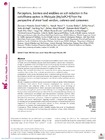| dc.contributor.author | Arifen, Zainorain Natasha Zainal | |
| dc.contributor.author | Haron, Hasnah | |
| dc.contributor.author | Shahar, Suzana | |
| dc.contributor.author | Harun, Zaliha | |
| dc.contributor.author | Michael, Viola | |
| dc.contributor.author | You, Yee Xing | |
| dc.contributor.author | Manaf, Zahara Abdul | |
| dc.contributor.author | Majid, Hazreen Abdul | |
| dc.contributor.author | Chia, Yook Chin | |
| dc.contributor.author | He, Feng J. | |
| dc.contributor.author | Brown, Mhairi Karen | |
| dc.contributor.author | MacGregor, Graham A. | |
| dc.date.accessioned | 2024-04-05T10:30:05Z | |
| dc.date.available | 2024-04-05T10:30:05Z | |
| dc.date.issued | 2023-12-15 | |
| dc.identifier.citation | Zainal Arifen, Z. N., Haron, H., Shahar, S., Harun, Z., Michael, V., You, Y. X., Manaf, Z. A., Majid, H. A., Chia, Y. C., He, F. J., Brown, M. K., & MacGregor, G. A. (2023). Perceptions, barriers and enablers on salt reduction in the out-of-home sectors in Malaysia (MySaltOH) from the perspective of street food vendors, caterers and consumers. Public Health Nutrition, 27(1), e12. https://doi.org/10.1017/S136898002300277X | en |
| dc.identifier.issn | 1368-9800 | |
| dc.identifier.uri | https://aecc.archive.knowledgearc.net/handle/123456789/285 | |
| dc.description | Available under License - Creative Commons Attribution: https://creativecommons.org/licenses/by/4.0/ | en |
| dc.description.abstract | Objective:
To explore the perspectives, barriers and enablers on salt reduction in out-of-home sectors in Malaysia among street food vendors, caterers and consumers.
Design:
A qualitative study involving twenty-two focus group discussions and six in-depth interviews was conducted, recorded and transcribed verbatim. An inductive thematic analysis approach was employed to analyse the data.
Setting:
Two in-depth interviews and twenty-two focus group discussions were conducted face-to-face. Four in-depth interviews were conducted online.
Participants:
Focus group discussions were conducted among twenty-three street food vendors, twenty-one caterers and seventy-six consumers of various eateries. In-depth interviews were conducted among two street food vendors and four caterers, individually.
Results:
Consumers and food operators perceived a high-salt intake within Malaysia’s out-of-home food sectors. Food operators emphasised the necessity for a comprehensive salt reduction policy in the out-of-home sector involving all stakeholders. Consumers faced limited awareness and knowledge, counterproductive practices among food operators and challenges in accessing affordable low-Na food products, whereas food operators faced the lack of standardised guidelines and effective enforcement mechanisms and uncooperative consumer practices. Both groups expressed that food quality and price of salt were also the barriers, and they advocated for awareness promotion, enhanced regulation of manufactured food products and stricter enforcement targeting vendors. Consumers also suggested promoting and recognising health-conscious food premises, whereas food operators suggested on knowledge enhancement tailored to them, strategies for gaining consumers acceptance and maintaining food quality.
Conclusions:
These findings provide valuable insights that serve as foundational evidence for developing and implementing salt reduction policies within Malaysia’s out-of-home sectors. | en |
| dc.language.iso | en | en |
| dc.subject | Perceptions | en |
| dc.subject | Barriers | en |
| dc.subject | Enablers | en |
| dc.subject | Salt reduction | en |
| dc.subject | Out-of-home sectors | en |
| dc.subject | Food vendors | en |
| dc.subject | Caterers | en |
| dc.subject | Consumers | en |
| dc.title | Perceptions, barriers and enablers on salt reduction in the out-of-home sectors in Malaysia (MySaltOH) from the perspective of street food vendors, caterers and consumers | en |
| dc.type | Article | en |
| dc.identifier.doi | https://doi.org/10.1017/S136898002300277X | |
